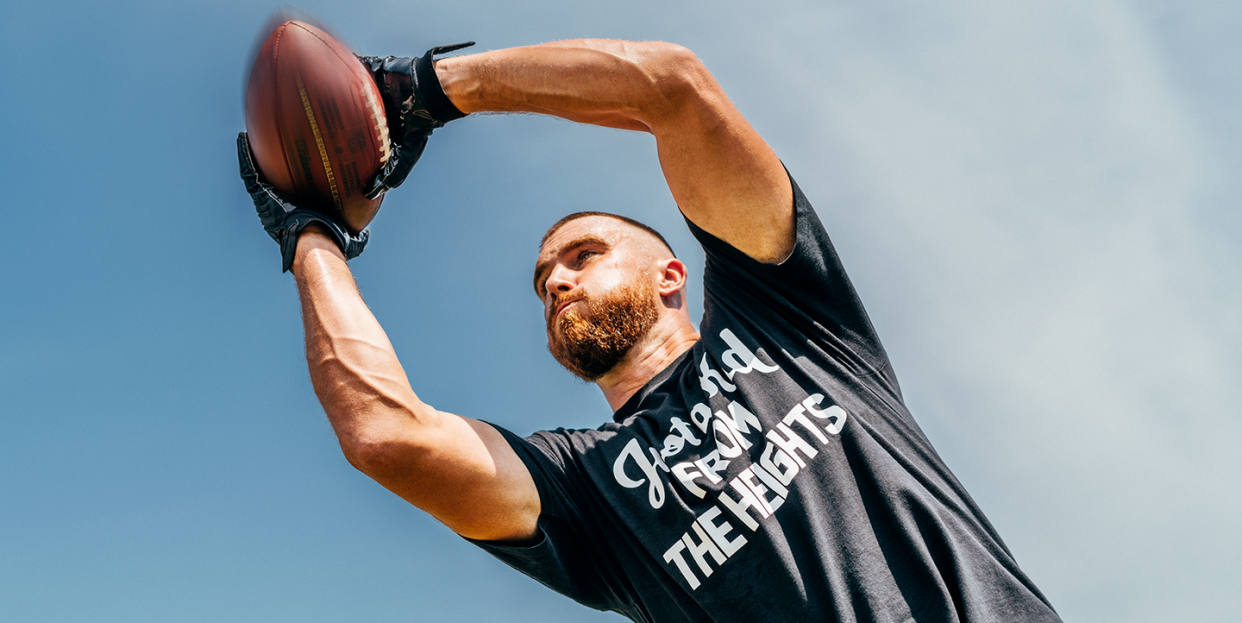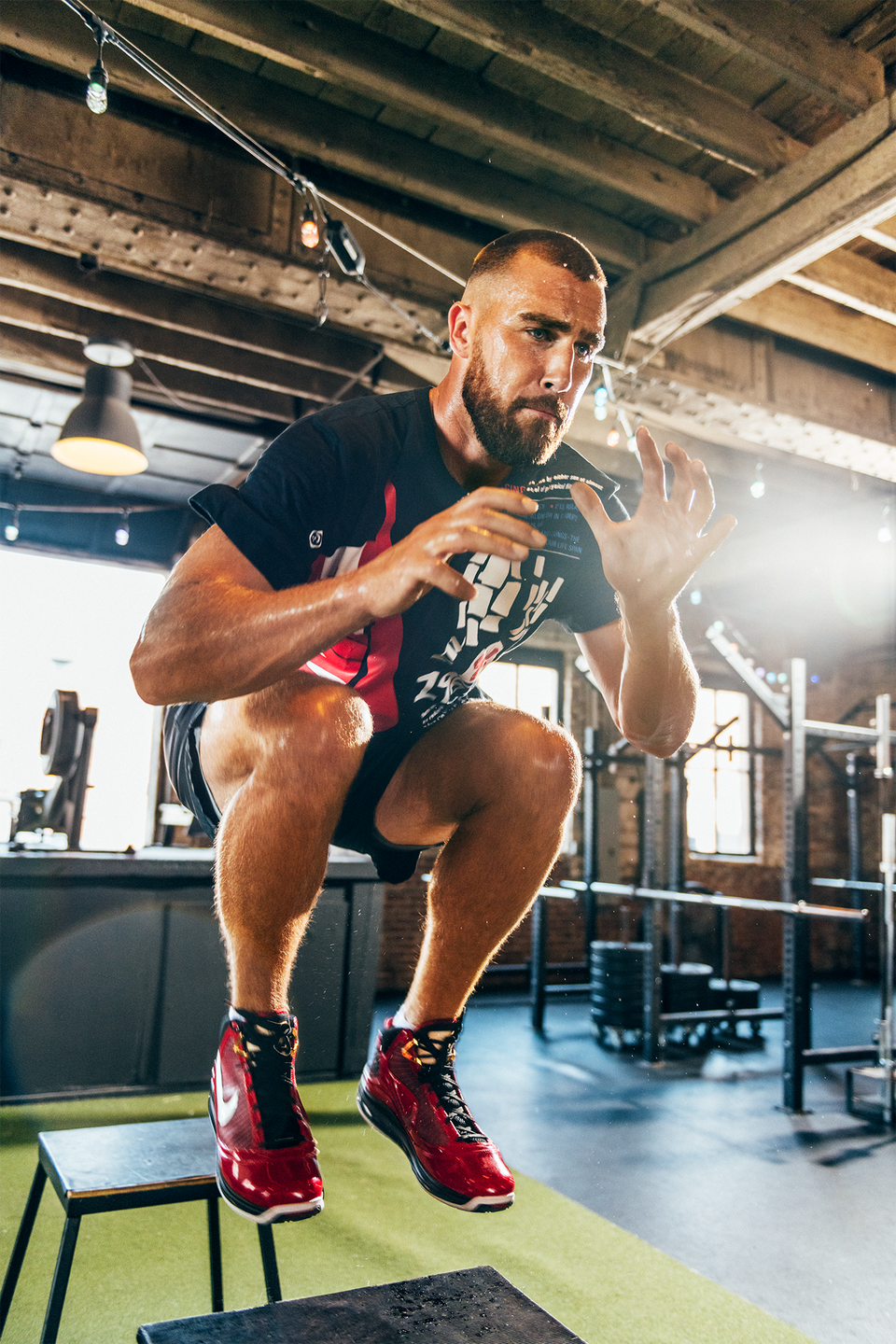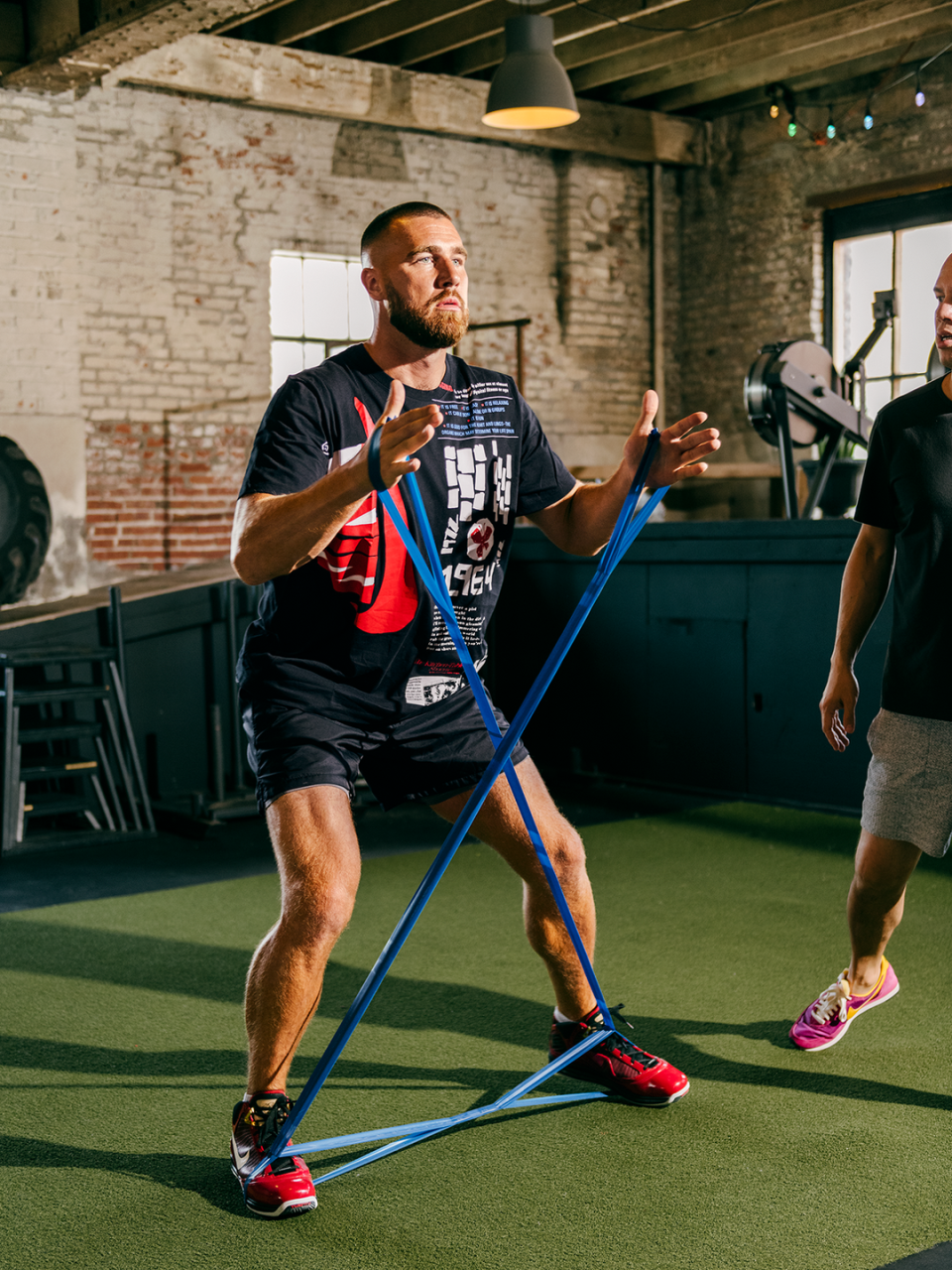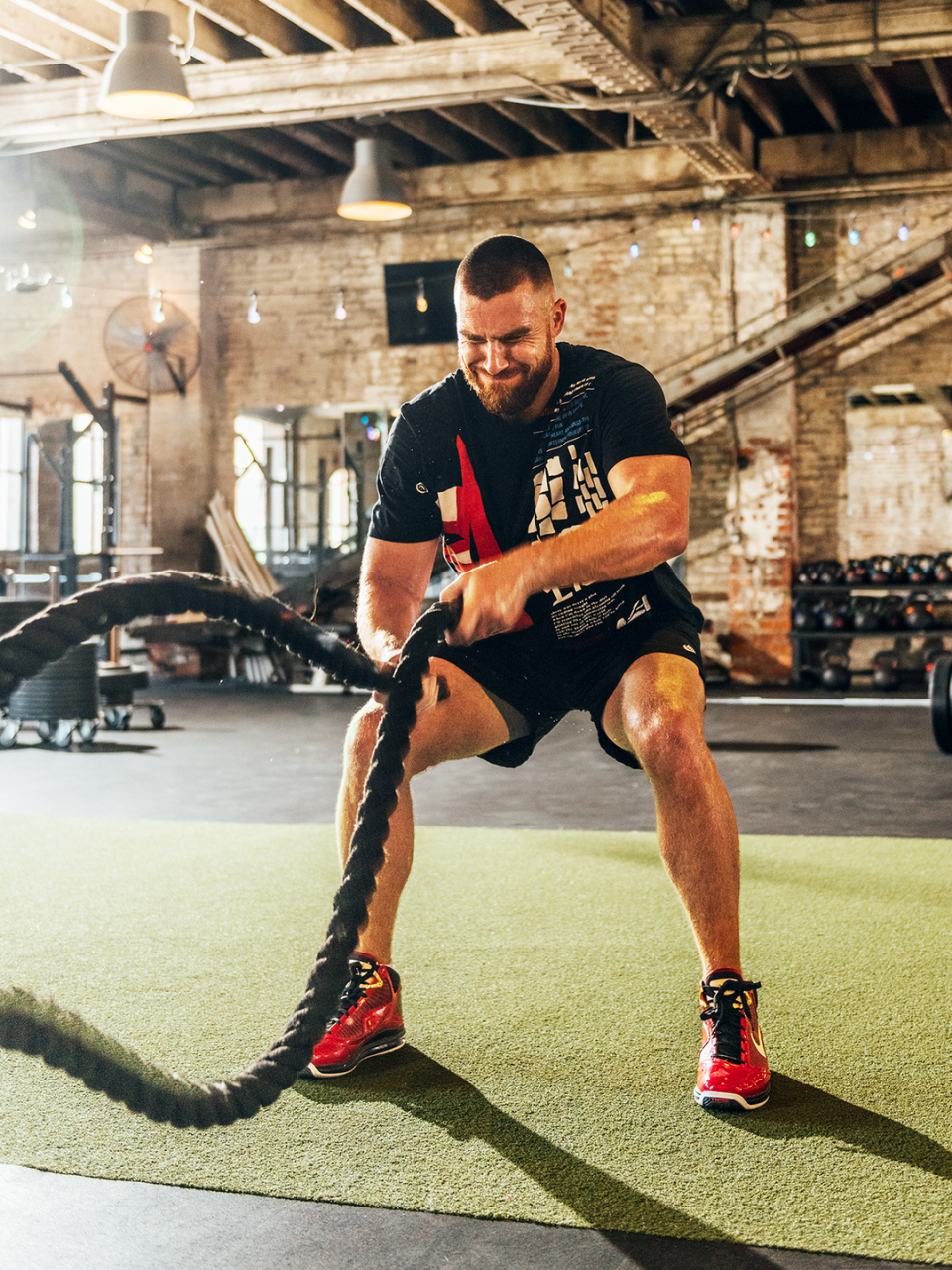How to Build Explosiveness Like NFL Star Travis Kelce

- Oops!Something went wrong.Please try again later.
- Oops!Something went wrong.Please try again later.
- Oops!Something went wrong.Please try again later.
HIS RIGHT OUTER hip wasn’t firing. And Travis Kelce wasn’t having it.
It was a hot June morning in KansasCity, and the Chiefs’ tight end was mid-way through a workout. Minutes earlier, Kelce had dashed five yards upfield, planted his right foot, and cut across the field for a catch. Now he was running the exact same play, but this time he took two baby steps before his cut and followed with another catch.
The catch didn’t matter; Kelce was thinking only about that sleepy right outer hip, which stabilizes your knee when you change direction, preventing injury and helping you explode. He walked up to his trainer, Alex Skacel, and pointed to his hip. He was done running routes. Kelce finished with 45-second side planks with his upper leg raised. “It’s on now,” he told Skacel. A day later, he was back to running routes. “I’ve really focused on the small stuff that keeps the big picture in mind,” Kelce says. “The rehab, the prehab, and what you can do to stay on the field and at your peak athleticism.”

It’s all that small stuff (yes, really) that turned Travis Kelce into the six-five, 255-pound manimal he is now, a player who enters the 2021 season as the NFL’s best tight end after three straight seasons of 90-plus catches and six Pro Bowl appearances. He’s also one of the NFL’s best real-world athletes at a position that’s finally getting the credit it deserves. Sure, receivers have more pure speed, offensive linemen are bigger and stronger, and cornerbacks can instantly change direction. But from Kelce to Tampa Bay legend Rob Gronkowski to hyped Atlanta Falcons rookie Kyle Pitts, modern tight ends have all those traits—and more.
Every Sunday, the 31-year-old Kelce needs enough speed to run past defensive backs and enough lateral quickness and raw power to block giant defensive line-men. He needs the core rigidity to shrug off would-be tacklers and the jumping ability to pluck passes out of the air. “Ask yourself, ‘What is a tight end?’” says Kelce. “It’s not just one position or one thing. We’re like the utility guy. Whatever you need done, we have to be able to have that attribute or that ability to just have success.”
It’s the toolbox every guy can use. Think about it: You don’t need Olympic-sprinter speed every day. But you do need a dose of explosive energy to catch that train you’re about to miss, a burst of agility to keep up with your kids during a game of tag, and the strength to pick up that Amazon box at your door. And Kelce’s cerebral, nuanced approach to fitness can help you build that while bulletproofing your body against injury, too.
KELCE BEGAN HONING his fitness approach long before he was catching passes from Patrick Mahomes and pushing the Chiefs to back-to-back Super Bowl appearances. In the fall of 2005, when he was a sophomore at Cleveland HeightsHigh in Ohio, his gym persona, “Trainer Trav,” was born. Kelce failed French class the previous year, which automatically made him ineligible to play football.
Except Kelce’s father convinced him to work with the team behind the scenes. So Trainer Trav taped ankles and gave out water on the sidelines of games. “That was the start of my appreciation for the anatomy of the body, understanding being healthy and at your peak athleticism at all times,” he says.
It blossomed when Kelce started playing at the University of Cincinnati in 2009. Early on, he suffered a shoulder injury and was assigned to work with a physical therapist. Instead of going through the motions of rehab, Kelce mentally cataloged the exercises that would build the muscles around his scapula, protecting his shoulders. He came to understand that he needed strong rhomboids and rotator-cuff muscles. “I was locking them in to where if I got a hold of a big, 300-pound guy and he’s throwing me all over the place like a rag doll, it keeps my shoulders protected,” he says.
By the time he was in the NFL, Kelce wanted to focus on training his stabilizing muscles. That jibed perfectly with Skacel, whom he began working with in 2017. Sure, he did exercises like squats, lunges, and rows. But he also got a heavy dose of lighter-weight motions. (See“Real NFL Muscle” below.) “We don’t want Travis’s body to rely only on the bigger muscles,” Skacel says. “All the things that make him great come off of that stable foundation that he’s built.”

A pair of trainers—Skacel, who describes himself as a “sports physical therapist,” and Florida-based Tony Villani—help Kelce do this, and the tight end contributes to those discussions by dissecting every single pass pattern he runs, just as he did on that June morning.But he refuses to do it on some 24/7/365 schedule. After the Chiefs fell to the Tampa Bay Buccaneers in February, Kelce took more than a month to do anything but fitness, an off-season tradition that he says readies his body to perform optimally once he dives back into training. “The thing is that the six months you’re in the season, you focus on it so much,” he says.“That’s a huge part for me to just rewind and regroup and just relax.”
Once Kelce starts his off-season, he focuses intently on those shoulders, a trouble spot for him throughout his career. (He had shoulder-labral-repair surgery in 2017.) Trainer Trav happily pops out to discuss them, too. “I’ve been a very bicep and chest and deltoid—I’ve been very closed as an athlete my entire life,” he says. “So what that does is it puts the AC joint at a very vulnerable position if I get hit the wrong way. Doing a lot of trap stuff, scapular stuff, lats, and really triceps . . . peels back more so that your posture is better and your overall athletic build is in a more safe position.”
Skacel supplements those exercises with consistent cupping and dry-needling sessions designed to relax Kelce’s tightest, sorest muscles, both during the season and in the off-season. Dry-needling and cup-ping encourage blood flow to muscles to help speed healing. But instead of relaxing after each round of therapy, Kelce immediately gets up and works through a light movement for ten to 12 reps to drive even more blood flow. So if Skacel dry-needles the tight end’s front shoulder, Kelce might do no-weight overhead presses or lateral raises to stimulate the joint even more.
It’s all made him one of the league’s must durable players; he’s missed just two games since 2014. “He invested in his body and he really, knock on wood, hasn’t had to deal with anything major,” Skacel says.
ALL THOSE SMALL movements prep Kelce’s body to train all out. He does that in three phases. Early each off-season, he’ll train his “get off,” exploding from a non-moving stance. Then he’ll train “immediate acceleration,” focusing on picking up speed as he runs routes. Finally, he’ll train his body to stop and start, something it must do whether he’s running a route or blocking a giant lineman.
Once he has started his off-season training, he never misses a workout. Skacel remembers traveling with him toParis Fashion Week in 2019, and after a day full of shows and events, at 12:30 a.m.the pair realized they hadn’t trained. Kelce’s fix: They walked to a bridge that crossed over a canal and ran eight400-meter sprints. “I don’t know anyone who would spend a full day at these run-way shows and then be like, ‘It’s 1:00 a.m.; let’s go run and work sprints and speedwork,’” says Skacel. “It was so important for him to know he’s taking advantage of every moment he has to get better.”
Sometimes, that just means getting his right outer hip firing.

REAL NFL MUSCLE
The strongest, most durable NFL bodies are built with more than squats, lunges, and deadlifts. Insert these stabilizing-muscle moves from Alex Skacel into your workouts to stay healthy (and get fast and strong, too).
You Might Also Like

